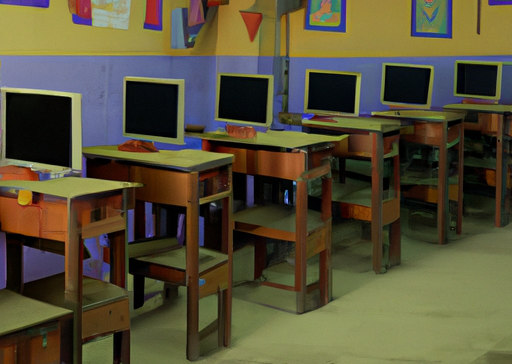The Digital Divide: Examining the Lack of Computer Labs in Indian Schools
The digital divide is a growing concern in India, where access to technology is limited in many areas. This is especially true in the country’s schools, where computer labs are often nonexistent or inadequate. This lack of access to technology can have a significant impact on students’ educational outcomes, as well as their future prospects.
In India, the majority of schools lack computer labs. This is due to a variety of factors, including limited budgets, inadequate infrastructure, and a lack of trained personnel. As a result, students are unable to access the technology they need to keep up with their peers in other countries. This can lead to a lack of digital literacy, which can have a negative impact on their future prospects.
The lack of computer labs in Indian schools can also have a negative impact on the quality of education. Without access to technology, students are unable to take advantage of the latest educational tools and resources. This can lead to a lack of engagement and a decrease in academic performance.
In order to bridge the digital divide in India, it is essential that schools have access to adequate computer labs. This can be achieved through increased funding, improved infrastructure, and the training of personnel. Additionally, it is important that students are taught digital literacy skills, so that they can make the most of the technology available to them.
The digital divide is a growing concern in India, and it is essential that steps are taken to ensure that all students have access to the technology they need to succeed. By providing adequate computer labs and teaching digital literacy skills, schools can help bridge the digital divide and ensure that all students have the opportunity to reach their full potential.
Exploring the Impact of Not Having Computer Labs in Indian Schools


The lack of computer labs in Indian schools is a major issue that has been overlooked for far too long. With the rapid advancement of technology, it is essential for students to be equipped with the necessary skills to keep up with the ever-changing digital landscape. Unfortunately, the lack of computer labs in Indian schools has had a significant impact on the quality of education that students receive.
Firstly, the lack of computer labs in Indian schools has resulted in students not being able to develop the necessary skills to use computers effectively. This is especially true for students from rural areas, who may not have access to computers at home. Without the opportunity to learn how to use computers, students are unable to take advantage of the many educational resources available online. This limits their ability to stay up to date with the latest developments in their field of study.
Secondly, the lack of computer labs in Indian schools has resulted in students not being able to develop the necessary skills to use computers for research. With the vast amount of information available online, students need to be able to use computers to search for and analyze data. Without the opportunity to learn how to use computers for research, students are unable to take advantage of the many educational resources available online. This limits their ability to stay up to date with the latest developments in their field of study.
Thirdly, the lack of computer labs in Indian schools has resulted in students not being able to develop the necessary skills to use computers for communication. With the increasing use of social media and other online communication tools, students need to be able to use computers to communicate with their peers and teachers. Without the opportunity to learn how to use computers for communication, students are unable to take advantage of the many educational resources available online. This limits their ability to stay up to date with the latest developments in their field of study.
Finally, the lack of computer labs in Indian schools has resulted in students not being able to develop the necessary skills to use computers for problem-solving. With the increasing use of computers in the workplace, students need to be able to use computers to solve complex problems. Without the opportunity to learn how to use computers for problem-solving, students are unable to take advantage of the many educational resources available online. This limits their ability to stay up to date with the latest developments in their field of study.
In conclusion, the lack of computer labs in Indian schools has had a significant impact on the quality of education that students receive. Without the opportunity to learn how to use computers effectively, students are unable to take advantage of the many educational resources available online. This limits their ability to stay up to date with the latest developments in their field of study. It is therefore essential for Indian schools to invest in computer labs in order to ensure that students are equipped with the necessary skills to keep up with the ever-changing digital landscape.
How Can We Bridge the Gap Between Schools With and Without Computer Labs in India?
In India, there is a large disparity between schools with and without computer labs. This gap can be bridged by implementing a few key strategies.
First, the government should invest in providing computer labs to schools that do not have them. This could be done through grants or other forms of financial assistance. Additionally, the government could provide incentives to private companies to set up computer labs in schools. This would help to ensure that all schools have access to the same resources.
Second, schools should be encouraged to use technology in their classrooms. This could be done by providing training to teachers on how to use technology in the classroom. Additionally, schools should be encouraged to use online resources such as educational websites and online learning platforms. This would help to bridge the gap between schools with and without computer labs.
Finally, schools should be encouraged to form partnerships with local businesses and organizations. These partnerships could provide access to computers and other technology resources. Additionally, these partnerships could provide mentorship and guidance to students on how to use technology.
By implementing these strategies, the gap between schools with and without computer labs in India can be bridged. This would help to ensure that all students have access to the same resources and opportunities.
The Benefits of Computer Labs in Indian Schools: A Look at the Evidence
The use of computer labs in Indian schools has become increasingly popular in recent years, as educators recognize the potential of technology to enhance the learning experience. This article will explore the evidence that supports the use of computer labs in Indian schools, and discuss the potential benefits that they can bring.
First, computer labs can provide students with access to a wide range of educational resources. By having access to the internet, students can access a wealth of information and resources that can help them to develop their knowledge and skills. This can include online tutorials, educational videos, and interactive activities. Furthermore, computer labs can provide students with access to software and applications that can help them to develop their technical skills.
Second, computer labs can help to foster collaboration among students. By having access to the same resources, students can work together to solve problems and develop their understanding of a particular topic. This can help to create a more engaging learning environment, as students are encouraged to work together and share ideas.
Third, computer labs can help to improve student engagement. By providing students with access to technology, they can become more engaged in their learning. This can help to improve their motivation and focus, as well as their overall academic performance.
Finally, computer labs can help to reduce the cost of education. By providing students with access to technology, schools can reduce the need for expensive textbooks and other materials. This can help to make education more affordable for students and their families.
In conclusion, the evidence suggests that computer labs can bring a range of benefits to Indian schools. By providing students with access to educational resources, fostering collaboration, and improving student engagement, computer labs can help to improve the quality of education in India. Furthermore, they can help to reduce the cost of education, making it more accessible to all.
How Can We Help Schools Without Computer Labs in India?
In India, many schools lack the resources to provide students with access to computer labs. This lack of access to technology can be a major obstacle to students’ educational success. Fortunately, there are a number of ways to help schools without computer labs in India.
One way to help is to provide schools with the necessary hardware and software. This could include computers, laptops, tablets, and other devices, as well as the necessary software and programs. Additionally, providing schools with internet access can help students access online resources and educational materials.
Another way to help is to provide training and support for teachers and students. This could include training on how to use the technology, as well as support for troubleshooting any technical issues. Additionally, providing teachers with access to online resources and materials can help them create engaging and effective lessons.
Finally, providing schools with access to educational grants and funding can help them purchase the necessary technology and resources. Additionally, providing schools with access to mentors and experts in the field can help them develop effective strategies for using technology in the classroom.
By providing schools with the necessary hardware, software, and training, as well as access to educational grants and mentors, we can help schools without computer labs in India. This can help ensure that all students have access to the technology they need to succeed in their studies.









